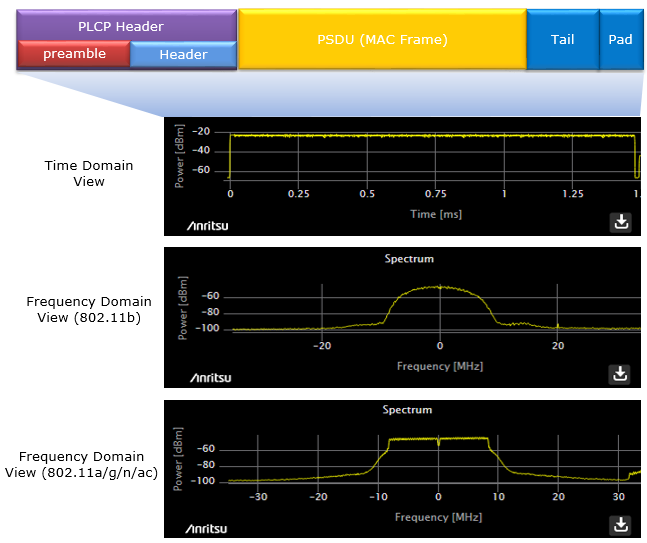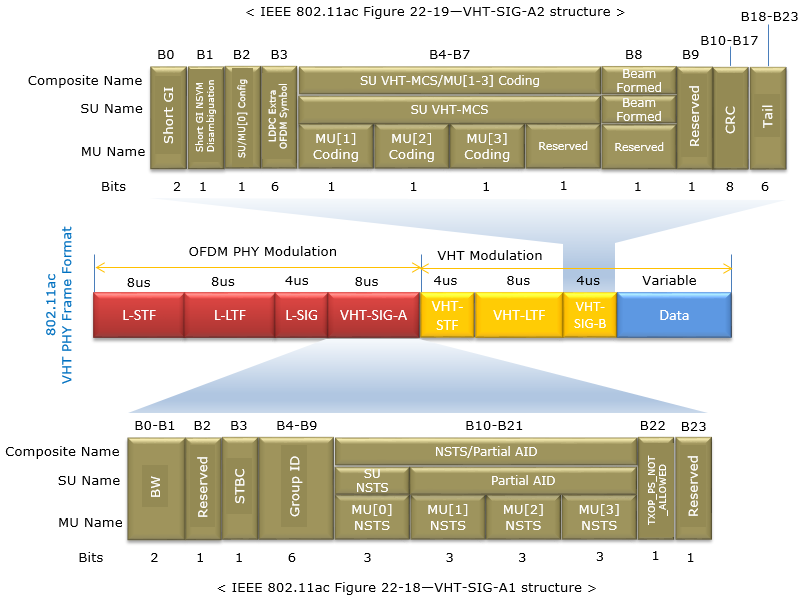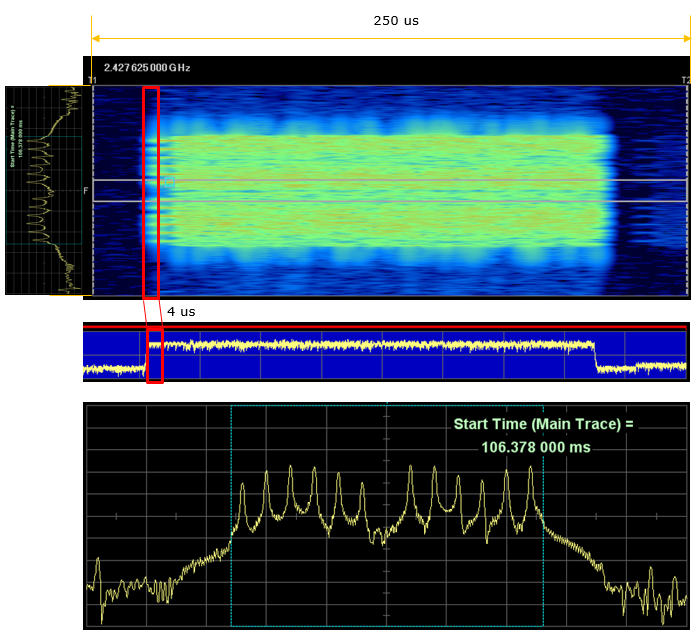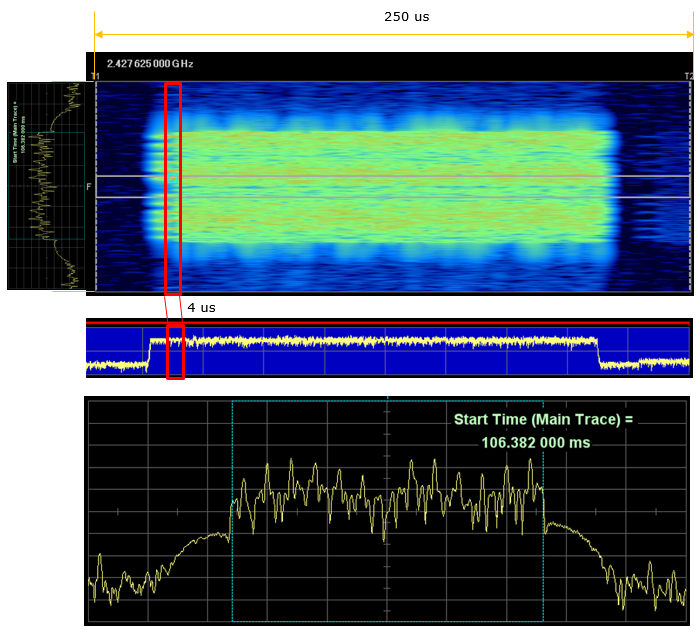|
PHY Frame
Going into very details, 802.11 Physical Frame structure gets different from each standard(e.g, b/g/a/ac etc) and it is difficult to draw a single diagram to represent the physical frame structure of every WLAN standards. However, taking a very high level view, the physical frame structure of WLAN can be represented as follows.

There are many different ways to represents PHY frames. Most common way would be to draw various diagram as you can easily find from specification documents or web search. I will use various diagrams as well, but I would try to put various captures from measurement equipment trying to give you more intuitive and realistic image.
WLAN is using roughly two types of modulation method, DSSS and OFDM. DSSS is a kind of old technology which is the base technology for 802.11b and most of recent standard like 802.11a, g, n, ac are all based on OFDM. Following is summary of requency domain structure for OFDM based WLAN standard.

The time domain structure or Physical Layer (PHY) frame structure of WiFi, as defined by the IEEE 802.11 standards, encompasses the organization of data, control information, and management information as they are transmitted over the air. This structure is crucial for ensuring reliable communication between WiFi devices.
The PHY frame structure can vary slightly depending on the specific version of the 802.11 standard being used (e.g., 802.11a, 802.11b, 802.11g, 802.11n, 802.11ac, etc.), as each version may introduce different modulation schemes, data rates, and channel bandwidths. However, the basic concept of a preamble, header, and payload remains consistent across these variations.
The design of the PHY frame structure is critical for the efficient use of the wireless medium, supporting various service qualities, and enabling coexistence with other signals in the same frequency band. It allows for dynamic adjustments in response to changes in signal strength, interference levels, and other factors affecting wireless communication.
Overall structure of WiFi PHY frame is made up of :
- Preamble and Header: At the beginning of each WiFi frame, there is a preamble and header. The preamble is used for synchronization, allowing the receiver to establish the timing of the incoming signals. It also aids in signal detection and equalization. The header contains important control information, such as the rate at which the data is transmitted and the length of the payload.
- Payload: Following the header, the payload carries the actual data being transmitted. Majority part of the PHY payload is a MAC frame that can include user data, network management information, or control messages. The size of the payload varies depending on the type of frame and the specific requirements of the data being sent.
This is a diagram of the PHY frame structure for the 802.11a standard.

This is breakdown of this frame :
- PLCP Header: This is located at the beginning of PHY frame and it is made up of two parts - PLCP Preamble and Signal.
- PLCP Preamble: This is the Physical Layer Convergence Protocol preamble. It's used for synchronization and consists of 12 symbols that help the receiver to lock onto the signal and understand the modulation and coding schemes being used.
- Signal: It's a part of the PLCP header and it carries the information as follows
- Rate (4 bits): Indicates the data rate at which the packet is transmitted.
- Reserved (1 bit): A reserved bit for future use or to maintain compatibility.
- Length (12 bits): Specifies the length of the PSDU (PLCP Service Data Unit), which is the actual data payload.
- Parity (1 bit): A bit to check the correctness of the header.
- Tail (6 bits): These are extra bits used to flush the convolutional decoder within the receiver.
- Data: This is the actual payload that carries the user data. It's divided into:
- Service (16 bits): Used for various service functions within the PHY layer.
- Payload: This is the variable-length field that carries the MAC frame
- Tail (6 bits): Similar to the tail bits in the PLCP header, these are used to clear out the decoder.
- Pad: Padding bits are used to ensure that the data payload is an integer number of symbols. The length of the pad varies depending on the size of the payload.
This is overall structure of 802.11n PHY frame( also known as High Throughput (HT) Wi-Fi). It significantly improved data throughput and range over previous Wi-Fi standards through the use of multiple antennas, wider RF bandwidth, and more advanced signal processing. The 802.11n PHY frame structure supports enhanced modulation and coding schemes, allows for multiple spatial streams, and can utilize wider channel bandwidths, all of which contribute to the increased throughput and range of this
standard compared to its predecessors.
The IEEE 802.11n standard introduced several enhancements over previous Wi-Fi standards, particularly with the PHY layer, to increase throughput. A notable feature of 802.11n is its ability to operate in different PHY modes to accommodate both older and newer devices: Legacy, Mixed, and Greenfield modes. These modes dictate how the PHY header is structured to either allow backward compatibility or to provide optimized performance.
Each of these modes has a specific use case:
- Legacy Mode: Ensures that new 802.11n devices can communicate with older devices but doesn't take advantage of 802.11n's speed enhancements.
- Mixed Mode: Provides compatibility with older devices while allowing 802.11n devices to benefit from some of the standard's enhancements. If there are legacy devices in the area, the network typically operates in Mixed Mode to prevent interference and ensure all devices can understand the transmissions.
- Greenfield Mode: Optimizes performance for 802.11n devices, excluding older devices from the network. When an 802.11n device is communicating in Greenfield mode, it sends out a preamble that is only understandable by other 802.11n devices. This preamble signals that the following transmission will be using 802.11n-only features like MIMO or channel bonding, which are not compatible with older standards.

Following is the structure of the mixed mode frame.
The Mixed Mode Frame Structure in IEEE 802.11n is designed to ensure compatibility with legacy devices operating under older 802.11 standards such as 802.11a/b/g while providing the benefits of the n standard's enhancements. It allows 802.11n-compliant devices to communicate at high throughput rates without excluding legacy devices from the network.
The Mixed Mode frame structure is a combination of fields understandable by both legacy and HT (High Throughput) devices. It begins with a preamble that is compatible with legacy devices, followed by HT-specific fields that are ignored by legacy devices. After the preamble, there is an HT frame that includes the HT Signal field (HT-SIG), HT Short Training Field (HT-STF), and HT Long Training Fields (HT-LTFs). Finally, the frame carries the actual data payload.
The Mixed Mode frame structure thus supports communication in environments where both legacy and HT devices are present, ensuring that 802.11n devices can take advantage of higher data rates and more robust signal processing while maintaining backward compatibility with older Wi-Fi technologies.

Followings are breakdown of the frame structure
- L-STF (Legacy Short Training Field): An 8-microsecond field used for signal detection, AGC (Automatic Gain Control), and setting the radio frequency timing for legacy devices.
- L-LTF (Legacy Long Training Field): Another 8-microsecond field for fine-tuning frequency offset and channel estimation for legacy devices.
- L-SIG (Legacy Signal Field): A 4-microsecond field containing rate and length information readable by legacy devices, ensuring they can process the frame correctly up to this point.
- HT-SIG (High Throughput Signal Field): A two-symbol field specifically for 802.11n devices, carrying information required for decoding the HT data, such as MCS index, channel bandwidth, and guard interval.
- HT-STF (High Throughput Short Training Field): This is used for channel estimation in an 802.11n environment and lasts for 4 microseconds.
- HT-LTF (High Throughput Long Training Field): Used for fine channel estimation, MIMO channel calibration, and sounding. The number of HT-LTFs sent depends on the number of spatial streams being used.
- Data: Contains the MAC Service Data Unit (MSDU) or Aggregate MAC Service Data Unit (A-MSDU), along with any necessary padding bits and tail bits for proper decoding.
Following is the PHY frame structure for a Greenfield format in the IEEE 802.11n standard. The Greenfield format is designed for an environment where only 802.11n devices are present and therefore does not need the legacy preamble and header. Greenfield mode can enhance efficiency because it skips the legacy preamble and header, reducing overhead and allowing for a shorter transmission time, which can improve network throughput under the right conditions.

Here's a breakdown of the Greenfield frame structure:
- L-STF (Legacy Short Training Field): Even though it's a Greenfield frame, this initial short training field is included for backwards compatibility with legacy devices that may still be present in the environment.
- HT-LTF1 (High Throughput Long Training Field 1): The first long training field specific to 802.11n, which is used for channel estimation. It's critical for MIMO operations and allows for fine-tuning the signal processing based on the current channel conditions.
- HT-SIG (High Throughput Signal Field): A field specific to 802.11n that provides detailed information about the transmission, such as the Modulation and Coding Scheme (MCS), data rate, and length of the frame.
- HT-LTFs (High Throughput Long Training Fields): Additional training fields are included based on the number of spatial streams being used. In a full MIMO configuration (e.g., 4 spatial streams), you would have one HT-LTF for each spatial stream.
- The first part of HT-SIG field includes:
- MCS (Modulation and Coding Scheme, B0-B6): This indicates the modulation and coding used for the data fields of the frame.
- Bandwidth (R, B4): Signifies whether a 20 MHz or 40 MHz channel is used.
- Length: The duration of the frame.
- The second part of HT-SIG are as follows:
- B0: Smoothing required or not.
- B1: Not sounding PPDU.
- B3: Reserved.
- B4-B5: Aggregation.
- B6: STBC (Space-Time Block Coding) supported or not.
- B7: Advanced coding (LDPC) used or not.
- B8-B9: Short Guard Interval (SGI) used or not.
- B10-B17: Length of the data in octets.
- B18-B23: Number of spatial streams minus one.
- Data: This is the main payload section, which carries the MAC frame including the MAC header, frame body, and Frame Check Sequence (FCS).
Following is a representation of the PHY frame format and modulation specifics for the 802.11ac VHT (Very High Throughput). It shows the division of the signal into different fields, each with a specific function and duration in microseconds. The purpose of this structure is to allow devices to communicate the necessary information to decode and understand the subsequent data frames.

This frame is made up of two large segments :
- OFDM PHY Modulation: This part of the diagram shows the preamble of the frame, which includes different fields such as L-STF (Legacy Short Training Field), L-LTF (Legacy Long Training Field), L-SIG (Legacy Signal), and VHT-SIG-A, each with a specified duration in microseconds. These are used for synchronization, channel estimation, and signaling for legacy devices.
- VHT Modulation: This part specifies fields that are specific to the 802.11ac standard, such as VHT-STF, VHT-LTF, and VHT-SIG-B, also with specified durations. These fields are used for channel estimation, signaling for 802.11ac devices, and other functions.
Each of the segments carries VHT-SIG-A1 and VHT-SIG-A2 respectively
- VHT-SIG-A1:
- It's part of the frame preamble used for signaling in 802.11ac VHT (Very High Throughput) wireless communication.
- Contains information required by the receiver to decode the upcoming VHT frame.
- It's transmitted in a non-HT (High Throughput) format so that it can be decoded by devices not supporting VHT.
- Bandwidth (BW) field: Indicates the channel bandwidth (e.g., 20 MHz, 40 MHz, 80 MHz, etc.).
- STBC field: Indicates if Space-Time Block Coding is used for the transmission, which is a method to improve reliability.
- Group ID field: Used for group identification in multi-user MIMO environments.
- Number of Space-Time Streams (NSTS): Indicates the number of space-time streams used in the transmission.
- Partial AID field: A shortened association identifier that helps the receiver identify the transmission's intended recipient.
- VHT-SIG-A2:
- Also part of the preamble, it complements the A1 segment by providing additional information needed for frame decoding.
- Transmitted using VHT modulation for devices that support VHT.
- Short GI (Guard Interval) field: Indicates whether a short guard interval is used, which can help increase data rate.
- Coding: Provides information on the coding used for the user’s data.
- MU-MIMO (Multi-User MIMO) Coding: Shows the coding for multi-user MIMO transmissions.
- Beamformed field: Indicates whether beamforming is used, which is a technique to direct signals towards specific receivers to improve signal quality.
- CRC (Cyclic Redundancy Check): A checksum for error-checking the VHT-SIG-A fields.
This is 802.11ad Control PHY Frame which carries control information which includes packet type, data length, and other parameters essential for the management and proper routing of the data packet through the network.

The composition of this frame is as follows :
- Preamble: This part of the frame is used for synchronization and includes the Short Training Field (STF) and the Channel Estimation Field (CEF). It allows the receiver to lock onto the signal and begin interpreting it correctly.
- Header: Contains vital information for the receiver, such as modulation and coding schemes, frame length, and other control information.
- Data: The actual payload of the frame, which includes the transmitted information or user data.
- BFT: BeamForming Training. This is used for directional communication, which is a feature of 802.11ad that allows devices to increase signal quality and range.
The frame uses π/2 – DBPSK modulation, which is a type of phase modulation used for robust, low-complexity communication in wireless systems.
The detailed elements in the Header include:
- Differential detector initialization (1 bit): Used for setting up the differential decoder at the start of the header decoding process.
- Scrambler initialization (4 bits): Provides the initial state for the scrambler, which is used to randomize the data and reduce the likelihood of long runs of zeroes or ones.
- Length (10 bits): Specifies the length of the data field.
- Packet Type (1 bit): Identifies the type of packet, which could be data or control.
- Training Length (5 bits): Indicates the length of the training field used for beamforming.
- Turnaround (1 bit): A bit indicating whether there is a switch from transmit to receive mode.
- Reserved (2 bits): Bits reserved for future use or for specific proprietary functions.
- HCS (Header Check Sequence - 16 bits): A checksum used for error detection in the header.
This is 802.11ad Single Carrier PHY Frame which carries control information which includes packet type, data length, and other parameters essential for the management and proper routing of the data packet through the network.

The detailed elements in the Header include:
- Preamble: The preamble is used to prepare the receiving system for the incoming frame. It includes the Short Training Field (STF) for signal detection, timing, and coarse frequency correction, and the Channel Estimation Field (CEF) for fine frequency and channel estimation.
- Header: This section contains metadata about the frame, including the transmission rate, frame length, and other control information necessary for the receiver to correctly decode the incoming data.
- Data: This is the payload of the frame, containing the user data that is being transmitted.
- Beamforming Training (BFT): This segment is used for the beamforming process, which is critical for communication in the 60 GHz band. Beamforming optimizes the signal quality and strength by focusing the transmission in a specific direction between the transmitter and receiver.
The modulation techniques indicated (π/2 – BPSK, QPSK, QAM16) refer to the types of modulation used for different parts of the transmission, indicating the method by which data is encoded into radio waves.
In the header, the fields include:
- Scrambler Initialization (7 bits): Sets up the pattern for scrambling the data to reduce interference and improve security.
- Modulation and Coding Scheme (MCS) (5 bits): Specifies the data rate and error correction methods.
- Length (18 bits): Indicates the length of the data field.
- Additional PPDU (1 bit) and Aggregation (1 bit): Indicate whether there are additional PPDU fields and whether multiple frames are aggregated together, respectively.
- Training Length (5 bits): Specifies the length of the training field for beamforming.
- Beam Tracking Request (1 bit): Indicates if beam tracking is required for the connection.
- Last RSSI (4 bits): Represents the last received signal strength indication, which is a measure of the signal power in the received frame.
- Reserved/Unused (4 bits): Reserved for future use or customization.
- Turnaround (1 bit): Indicates if a transition from transmit to receive mode is needed.
- Header Check Sequence (HCS) (16 bits): A checksum used to verify the integrity of the header information.
This is 802.11ad Low Power Single Carrier PHY Frame which carries control information which includes packet type, data length, and other parameters essential for the management and proper routing of the data packet through the network.

Here is the high-level functionality of this frame:
- Preamble: Contains the Short Training Field (STF) and the Channel Estimation Field (CEF), which are used to synchronize the receiver to the signal and estimate the channel conditions, respectively. The preamble prepares the receiver for the data that follows and ensures the accuracy of the signal reception.
- Header: Provides the receiver with essential information needed to decode the data section of the frame. This includes the modulation and coding scheme (MCS), the length of the data, and other parameters.
- Data: The main payload of the frame, containing the information intended to be transmitted to the receiver.
- Beamforming Training (BFT): A section used for beamforming, which is a process to direct the wireless signal towards the specific receiver to optimize the connection quality, especially important in the 60 GHz band where signals have high directionality.
The frame uses π/2 – BPSK modulation for the Preamble and Header to ensure robustness and better range, even at low power, while the Data section can use more advanced modulation schemes like QPSK to increase throughput.
The specific fields in the Header include:
- Scrambler Initialization (7 bits): Sets up the initial state of the scrambler to randomize the data, which helps in reducing interference and improving security.
- MCS (5 bits): Defines the data rate and error correction coding.
- Length (18 bits): Specifies the length of the data payload.
- Additional PPDU (1 bit): Indicates if there is additional PHY Protocol Data Unit information.
- Packet Type (1 bit): Distinguishes between different types of packets.
- Training Length (5 bits): Indicates the duration of the training for beamforming.
- Aggregation (1 bit): Signifies whether multiple frames are aggregated together.
- Beam Tracking Request (1 bit): Indicates if beam tracking is needed.
- Last RSSI (4 bits): Provides the last Received Signal Strength Indicator, which is a measure of the signal power level.
- Turnaround (1 bit): Indicates whether a switch from transmit to receive is required.
- Reserved (4 bits): Space reserved for future use or proprietary features.
- Header Check Sequence (HCS) (16 bits): A checksum for error detection to ensure the header is correctly received.
This is 802.11ad OFDM PHY Frame which carries control information which includes packet type, data length, and other parameters essential for the management and proper routing of the data packet through the network.

Here is the high-level functionality of this frame:
- Preamble: Comprising the Short Training Field (STF) and Channel Estimation Field (CEF), it allows the receiver to lock onto the signal, synchronize, and estimate the channel characteristics.
- Header: This contains control information that describes how the Data section is encoded and how it should be processed. This includes the modulation scheme, length of the data, and other parameters needed for decoding.
- Data: The main content of the frame, which carries the actual information to be communicated.
- Beamforming Training (BFT): A necessary step for the 60 GHz frequency band to optimize the transmission path between the transmitter and receiver, enhancing signal focus and reception.
The modulation schemes shown (π/2 – BPSK for Preamble/Header and various forms of QPSK and QAM for Data) indicate the type of modulation used for different parts of the frame. The Preamble and Header use a more robust modulation scheme to ensure proper reception under various conditions, while the Data section can use higher-order modulation schemes to increase data throughput.
The detailed components of the Header are as follows:
- Scrambler Initialization (7 bits): Provides the initial state for the scrambler to help protect against interference and provide a level of security.
- Modulation and Coding Scheme (MCS) (5 bits): Specifies the data rate and error correction schemes.
- Length (18 bits): Indicates the length of the Data field.
- Additional PPDU (1 bit): Signifies if there is more PPDU (PHY Protocol Data Unit) information to follow.
- Packet Type (1 bit): Distinguishes the packet type for appropriate processing.
- Training Length (5 bits): Specifies the length of the training field for beamforming.
- Aggregation (1 bit): Indicates if multiple frames are aggregated together.
- Beam Tracking Request (1 bit): Signals if beam tracking is needed for maintaining the communication link.
- Tone Pairing Type (1 bit) and DTP Indicator (1 bit): Used for specifying details about the OFDM sub-carriers.
- Last RSSI (4 bits): Indicates the last received signal strength to gauge the quality of the received signal.
- Turnaround (1 bit): Indicates a change from transmit to receive mode, if needed.
- Reserved (4 bits): Space reserved for future use or proprietary extensions.
- Header Check Sequence (HCS) (16 bits): A checksum for error detection to ensure the header's integrity.
In this section, I will provide a list of snapshots of WLAN RF signals in different formats like spectrogram, power vs time and frequency waveform at a specific point in time. The purpose is to help you with building up some intuitions on how those signal look like. I would not explain the details verbally. I assume that you have a certain degree of understandings on spectrum analysis (i.e, meaning of spectrogram, power vs time and frequency waveform). With this type of basic understanding, try to make sense out of these snapshots by yourselves.












Reference :
[1] 802.11 OFDM Overview
[2] 802.11n Signal Structure
[3] 802.11ac Signal Structure
[4] WLAN 11ac frame format
[5] WLAN - 802.11 a,b,g and n
[6] 802.11n Tutorial
[7] SIGNAL and HT-SIG
|
|






















